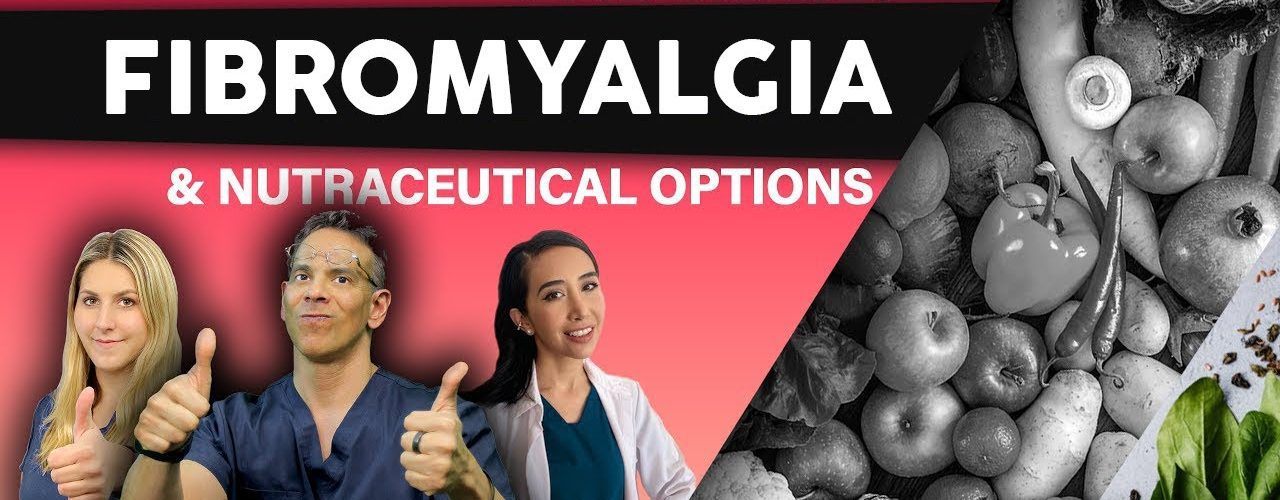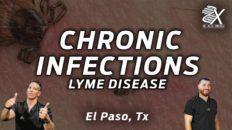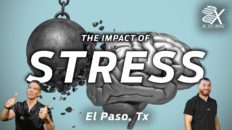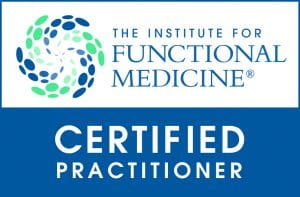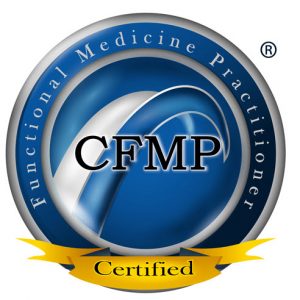Table of Contents
Introduction
In today’s podcast, Dr. Alex Jimenez and Master Nutritionist Ana Paola Rodriguez Arciniega discuss what kinds of foods can dampen the effects of fibromyalgia in the body.
How To Dampen Fibromyalgia Effects In The Body?
[00:00:05] Dr. Alex Jimenez DC*: Hey, guys, we’re going to be talking today about again, fibromyalgia. Fibromyalgia seems to be affecting a whole bunch of people. We want to talk about today, as we’ve been doing this part of our service, to understand what we have to deal with in practice regarding fibromyalgia. Now patients come to us in a lot of discomfort and pain where the diagnosis of fibromyalgia turns out to be the implicating cause. Now, whether the inflammatory state of the individual is caused by just a mitochondrial deficiency or a neurological disorder, or a thing called central sensitization, meaning super sensitive nerves, we want to figure out what the cause is. Today, we will be talking a bit about the pathophysiology and the nutritional components. But I’m going to be bringing in Ana Paola Rodriguez Arciniega to discuss a bit of the concept of nutritional applications for the person suffering fibromyalgia. Now, when I say that this is not a dogmatic point of view, is it a point of view by research. And what we want to do is we want to put the best options forward for the individual because sometimes the doctors will give you after an extensive series of assessments from clinical assessments to laboratories. They come to the road, and they say you got fibromyalgia, of which it’s easy to diagnose the fibromyalgia patients. Still, it’s not easy to develop the reasons and the cause underlying issues. So I’m going to present Ana Paola, and we’re going to be talking about nutritional components and how to look at and how to treat from something that you can do inside of your home. So here we go. So Ana Paola, welcome to the show. How are you doing?
[00:03:09] Ana Paola: Hello, I’m fine. How are you?
[00:03:11] Dr. Alex Jimenez DC*: Oh, we’re doing wonderful today. So we’re going to get loud.
[00:03:15] Ana Paola: Yes, we will get loud.
[00:03:17] Dr. Alex Jimenez DC*: We’re going to start telling about fibromyalgia. We’re going to start nailing this in because it’s a huge problem that affects many people and has a lot of drummers associated. The nutritional way is often a way that you, the individual, have control in the beginning. So let’s start talking about that. I know you’re going to share a screen, and we will be going into that area. So as you set up the sharing of the screen, tell us a bit of your approach to how you’re going to discuss our nutritional treatments for fibromyalgia patients.
[00:03:51] Ana Paola: Well, first of all, I want to say that since it’s such a broad of physiology, we’re going to be digging into each and every single one of the symptoms that are affecting, affecting the patient with fibromyalgia. So we’re going to go through that symptom. Then we’re going to start looking at the different approaches, nutritional approaches, new foods, new nutrients, new amino acids or, well, maybe not new, but we’re going to explain how those particular foods can affect and can improve everything that’s going on with this patient. And as you said before, nutritional diet therapies like one of the only things that make the patient feel like they have some control. So that is something really important. Another thing that we’re going to talk about is alternative treatments that have to come along with the nutritional approach; maybe with a pharmacological approach too; we don’t want to limit the approach of any patient because everyone is different and they are allowed to think different. So we’re just going to go through a whole new part of the treatment of fibromyalgia and nutritional treatment, and some alternative treatments.
[00:05:27] Dr. Alex Jimenez DC*: You know, you mentioned some of the approaches. Many people don’t know that you’re a master of nutrition and an educator in this process. So I’m very excited to see what this has to offer because I’m also going to add in as I go through the process with you. So take it away.
[00:05:45] Dr. Alex Jimenez DC*: Okay. So we said we want to treat exactly the symptoms and the physiology of fibromyalgia. I’ve noticed that a lot of the criteria have been changing, so that is something that we might want to take into account. We’re not going to see the same symptoms in each patient most of the time. So I want to be very clear on that. The patient has to be aware of what are the signs that are affecting their body within. So that is something that I want to clarify. So that will be part of that alternative treatment, but it has to come before that first assessment, or it could be done in the healing process. But yes, you have to be very aware of exactly why it is affecting you. Fibromyalgia, a big part of fibromyalgia, as you said before, is central sensitization and the pain that the patient is suffering. So we might want to talk a little more about what this pain sensation is and how it gets so bad and would never fibromyalgia start to suffer it? So the first thing that we have to know is that central sensitization has to do a lot with the fact that an excessive amount of glutamate, which we already stated before, is not wrong. It’s needed. It’s not a bad thing. But when there are like high amounts of glutamate that they come through our brain barrier, blood-brain barrier because it’s so permeable, that is the thing that is going to start to affect the patient. So right now, we want to see that glutamate, which is like the blue balls, will affect postsynaptic pain. So that is what enhances the pain sensation in some patients. So this is something that we want to lower a bit. And as I said before, the nutritional treatment is that combination with taking out some agents from your diet or just diminishing the amount that you are consuming and adding some anti-inflammatory and antioxidant food for it to get better, so something that can be helpful right here because as we’ve said, how are you going to know that glutamate is affecting you? Well, most of this with immunogenic exit’s ability comes with much pain, irritation, and IBS. So be aware of those symptoms. And then…
[00:08:58] Ana Paola: That’s where it counts.
[00:09:00] Dr. Alex Jimenez DC*: Ana, you mention IBS; you’re talking about irritable bowel syndrome, correct?
[00:09:05] Ana Paola: Yes.
[00:09:05] Dr. Alex Jimenez DC*: And what we’ve learned today when I went to school. Irritable bowel syndrome was considered diarrhea or constipation. Now we have what was called irritable bowel syndrome. C. and irritable bowel syndrome D for both. So what we directly can relate to is that it is fragmented into other areas in irritable bowel syndrome. I will venture to say that most of my patients with fibromyalgia have intestinal issues, pretty much all there. So go ahead and continue.
[00:09:34] Ana Paola: OK. So we’re going to talk about IBS and constipation or diarrhea that might come with those symptoms. But I want to say a little more here in the glutamate portion. Well, have you taken glutamine as part of your treatment or your muscular development treatment?
[00:09:58] Dr. Alex Jimenez DC*: Yes, we use glutamine. We use we use GABA. We focus on making sure that the levels are maintained. And the neurological testing that we do explicitly measures the glutamate level within the bloodstream and intracellular and extracellular. So we, as you mentioned, glutamine and glutamate, the precursors you’ll notice that they have cofactors that create the GABA, you know, adrenergic or at least the neurotransmitters that are occurring. So we measure these. Again, these are extremely, as you indicated, very, very important. We need them to function, but it’s when they have too much of it when the excess is when the load is too high, that we have these excessive depolarizations and issues resulting from it. So yes, we do.
[00:10:45] Ana Paola: Yes. So that’s exactly where I wanted to go. Glutamine glutamate is not bad because it will bulk glutamate, precisely when too much. It precisely will translate to excitotoxicity that would affect the patients. So what can we do actually to diminish this effect? Well, magnesium plays an important part because it has a cleft in the synaptic part of the receptors, which will block that glutamate entering would have made to the to their side, so it is very important. Another thing you might want to consider is that it’s very important to you to modulate that poor response. So this is something that we might want to take into account. Another critical part of that nutrition is vitamin B6, a cofactor to glutamate, and will turn glutamate into Gaza, which acts as an inhibitory neurotransmitter. That’s precisely what you want to have. So if you’re having problems and maybe you don’t know what is going on with your brain because as I said before, in my day, it might be difficult, but you might want to take into account that these are specific nutrients that you can add to your diet as maybe a supplement or maybe…
[00:12:38] Ana Paola: A lot of foods contain magnesium.
[00:12:40] Dr. Alex Jimenez DC*: In today’s discussion, we will be discussing the magnesium, the zinc, the B6 cofactors, and at least the modulation between the enzymes that are important along, but bringing it home. We’re going to get it to the foods too. Continue.
What Type Of Foods Have Anti-Inflammatory Properties?
[00:12:55] Ana Paola: Yes, actually, another thing that we that will be helpful to reduce the toxicity will be omega-three fatty acids. And I think that this has a dual-factor of well-being because the main thing is that omega-three fatty acids can make like stem cell membrane a little more fluid, preventing any excitotoxicity from forming. But on the other hand, it’s a very powerful anti-inflammatory factor that we can use to avoid many unsatisfactory fibromyalgia symptoms. So this is something fundamental about MSG and aspartame as part of the diet. Before, I talked about the importance of knowing that aspartate and glutamate can come into the diet from various sources. So while we want to use them as GABA, we use them as part of the functions of our body that we want to enhance instead of going all the way around and affecting us. So if you are aware of this same sense, you might want to take away that energy from your diet, and you might want to take away aspartame sweeteners from your diet. So that is kind of easy to do and the practical sense. You can take away MSG, you can take away some sweeteners, and you can see if this elimination type of diet can enhance your well-being. So that is something that I think it’s easier to do instead of going the whole way around. And just to see if there is a specific symptom, you can take it away. But this is an easy thing to do, like an easy way out.
[00:15:17] Dr. Alex Jimenez DC*: It’s a simple
[00:15:18] Dr. Alex Jimenez DC*: thing to do, I guess. Right?
[00:15:20] Ana Paola: Yeah, it’s like a simple thing to do. Another thing is that excitotoxicity comes with oxidative stress, and oxidative stress comes with narrow inflammation. So that is something that can come from, and fibromyalgia starts to worsen. So we don’t want to go all the way through that. So I think this is when the clinician has to be very aware of their patient’s symptoms. So don’t just like, say, like, no, how could it be possible? No, you’re just stressed. Take this pill or anything. No really big into this patient’s issues because you don’t know what is happening and just ignore it. It would eventually get back to that patient, which could be depressed, and you don’t want to have that on your shoulders. At least that’s what I’m thinking. So you have to dig into the symptoms.
Resveratrol & Dark Chocolate
[00:16:26] Dr. Alex Jimenez DC*: You know, one of the things is is that the beauty of today is that the technology is such that it’s not my opinion anymore. We can assess the blood factors and determine if the individual has a high level of the oxidative state. So before it was kind of, we had normal blood work and had the SMAC twenty-four or CBC or a simple metabolic panel. Today, we can assess the minerals and factors and see the level of oxidative stress that the individual is metabolically in a quick moment. So that issue of understanding is really what is changing the advent of medicine to understand the oxidative state reactive oxygen species. Many cause oxidative stress in the body. However, what we need to do is find it, but we need to find natural ways to mitigate this issue. So I noticed that you had there a certain amount of supplements. There are resveratrol and green tea. Tell us a bit of that.
[00:17:25] Ana Paola: Yeah. So these are some excellent antioxidants that could prevent this kind of reactive oxygen species and oxidative stress. So we want to focus on that kind of food that might give a little bit more resveratrol. But you have to make sure that you don’t have to take a lot of wine to get resveratrol…
[00:17:57] Ana Paola: And drink the whole bottle.
[00:18:01] Dr. Alex Jimenez DC*: Wait. Are you telling us that having five or six glasses of wine is unnecessary anymore?
[00:18:07] Ana Paola: Maybe.
[00:18:08] Ana Paola: Yes, that’s precisely what I’m saying.
[00:18:10] Ana Paola: You don’t have to take like five of it. And actually, a funny thing to mention is that dark chocolate, I mean, it’s chocolate it can have. And we’re talking about dark chocolate. The thing about dark chocolate, that it has to be 80 percent of dark chocolate, not milk chocolate. So you have to make sure that you get the right chocolate when you want to try this out. Another thing is that the amount is significant. I don’t know if you’ve ever bought like this bar of dark chocolate at your house.
[00:18:55] Dr. Alex Jimenez DC*: Yes.
[00:18:57] Ana Paola: So there is this thing because it has a lot of fat, which is kind of good because it has antioxidants, but we have to make sure that the ratio is good. So the right amount for you to take of that dark chocolate is like one too small for a day. So that is the amount that will provide you with some protection. Antioxidant protection that will alleviate that ROS potential effects and oxidative stress. So you have to make sure that if you want to take a glass of wine, don’t take the whole bar of dark chocolate. I mean, you have to cut a small square and eat it for you to get good results, and they’re not being weighed in your entire life like you’re going to get better.
[00:20:00] Dr. Alex Jimenez DC*: You know what?
[00:20:02] Dr. Alex Jimenez DC*: You’ve made me think about something because, as part of many wine connoisseurs, they do get dark chocolate, and they and they sometimes use a glass of red wine to enhance the flavor. So that’s an opportunity where you have to have half a glass of wine and probably a little bit of dark chocolate. It will amplify the experience, I guess.
[00:20:28] Ana Paola: If you think about it, we’re still thinking about social distancing. And that’s like a good thing that you can have your talk with your husband or with your wife; you can drink a glass of wine, take a little bit of dark chocolate and have your antioxidant party like in the night or have a good read or something like that. So it could be enhancing their resveratrol properties and providing you with a good time for you to relax and enjoy your time as a trying period of life that we’re leaving, so I don’t know, but those are my ideas.
[00:21:23] Dr. Alex Jimenez DC*: Ana, you are correct.
[00:21:24] Dr. Alex Jimenez DC*: I will tell you that I’ve had more patience now with the exacerbations of fibromyalgia symptoms since even before being at home in this disassociation from humans. And this limitation of movement has created an inflammatory test for the body. So what we need to do is have ways, so this is a great option. I love this.
[00:21:46] Ana Paola: Yeah, so that is actually like the very functional part of resveratrol and where you can get it and how you can pair it, and now we are wine connoisseurs, but we need to know something that resveratrol can provide a lot of microbiological activation and prevent it from going to the phase two activation of microbial. So instead of getting all pro-inflamed and producing neuroinflammation, they will mitigate the effects of this pro-inflammatory effects of neuroinflammation. So, thank you resveratrol for giving us many good options.
[00:22:36] Dr. Alex Jimenez DC*: Yes.
Green Tea
[00:22:38] Dr. Alex Jimenez DC*: And you said green tea too? You mentioned polyphenols as well, so we were doing that, and let’s elaborate on that one, too as well.
[00:22:45] Ana Paola: So yeah, you were saying before that we can now measure a lot of our antioxidants and find power, and that is very important. So right now, in this research article, they found that supplementation of green tea and its powerful polyphenols can improve ecto-activity so that it’s something that you can take away from the green tea and include it in your diet. And maybe just like a simple tea bag of green tea won’t be helpful, but you can supplement green tea so that it can be a little more powerful. You can just use that as, for example, if you want to make a smoothie instead of just pouring water into it, you can make a small green tea and keep it in the fridge and add it to your smoothie. And that way, you can introduce green tea to your diet in a very simple way.
[00:23:59] Dr. Alex Jimenez DC*: Ana, today we have the pills of green tea extract about 500 to 600 milligrams a day is sufficient. So there are easy ways of doing that if you can’t get it. No simplifying your dynamics in your diet protocols.
[00:24:16] Ana Paola: Yes, that is important. And it’s like a good way of providing a nice extra layer to your diet.
[00:24:32] Dr. Alex Jimenez DC*: Yeah.
[00:24:36] Ana Paola: We need to talk about some muscular pain in the muscle and muscle metabolism that comes with fibromyalgia patients. Because something that you can see in patients is that they are not going to be very active because it hurts so, a lot of it is to try to find out what was happening, they thought it was lactic acid, but it had nothing to do with it. It’s still the sensory aspect and the fact that this kind of pathology has over mitochondrial dysfunction. So this is something that we can take a lot of these vitamins and micronutrients that I’m going to talk a little bit more about in a while so that we can apply them to the diet.
[00:25:45] Dr. Alex Jimenez DC*: So let me just begin that right here because one of the things that I want people to know is that fibromyalgia, really any human, doesn’t matter who you are. You could be the most well-adjusted individual. Any human who’s had pain for more than three months starts having depressive overtones. It doesn’t matter if you’re the happiest person in the world; it will affect you. And as it affects you, it devastates the family life. It devastates your outlook. It makes you suffer from sickness syndrome. You don’t want to go out. You become much, relatively more introverted in today’s situation because today we’re used to going out, but we’re limited. So on top of that, you don’t want to do anything. So we must understand the symptoms of the issues to break them down. So Ana is going to go over these components to assist people. But I want you to know we’re not going crazy when we have fibromyalgia. Things physiologically occurring do not need an SSRI or maybe an analgesic or some corticosteroid. So let’s talk about the ways we can fix this.
[00:26:54 Dr. Alex Jimenez DC*: Nitric oxide?
Nitric Oxide
[00:26:55] Ana Paola: So nitric oxide, we know a beneficial cardiovascular disease and how we can dilate everything. And it’s perfect for your arteries, but it’s not precisely suitable for fibromyalgia suffering patients. We already know that fibromyalgia is more common in females than in men. Something that has been brought to light is bad that nitric oxide can exacerbate the pain effects in this kind of patient. And it’s like the same thing that we’re talking about with glutamate. You’ll want to have the right amount of nitric oxide, but still, you want to stay away from those very powerful foods that are a trigger for nitric oxide production. Most of the patients have reported that they can associate the symptoms…
[00:28:22] Ana Paola: with eating citrus fruit.
[00:28:23] Ana Paola: I don’t know why I want to say onions, oranges, lemons, even strawberries can be like very acid at the time. And tomatoes can produce a little more pain or are associated with that. In this expertise, we must mention that most of them are like subjective questionnaires. So, I mean, some people can feel that same pain when they introduce tomatoes and citric fruits to their diet, and another person might not feel that way. So, we want to introduce our food that can regulate the nitric oxide contents inside the body. So while my grade citrus fruit, which I already told you, some people might say that they can feel a lot more pain when introducing them to their diet. Walnut rocket ladders, spinach, and L-citrulline inside a watermelon. So this was like a very like novel.
[00:29:43] Dr. Alex Jimenez DC*: Ana, now that you mention that…
[00:29:45] Dr. Alex Jimenez DC*: Walnuts, dark chocolate, dark chocolate covered walnut, you know, we got centers and whole foods that have the nuts and the dark chocolate together, which adds to this story. Excellent.
[00:29:59] Ana Paola: Yeah. So that is something that could be very useful, as a snack. Like practical, that will be the word of this webinar right now. It’s going to be practical for us today. We also have to mention that homocysteine, which seems to be a part of any pathology, is also part of fibromyalgia. Many high homocysteine levels have been found in cerebrospinal fluid in the brain of many fibromyalgia patients, so this might be related to loss collect cholesterol pain. So what you want to do is that you want to take that vitamin B12 inside your body through a lot of foods. And these are like very simple foods. And when we start talking about it’s like a little bit later in this talk right here, we’re going to begin to see that there is a lot of fish involved in this. And there’s a protein, and there’s a nutritional approach.
[00:31:17] Dr. Alex Jimenez DC*: Homocysteine is a notorious cellular byproduct that we use to measure inflammation and overall oxidative stress. We’ve also learned that homocysteine can be bound to by N-Acetyl-L-Cystine, not only for the glutathione reactions and the axon orcs that are the main antioxidant, which includes glutathione, but it NAC can bind to homocysteine and help eliminate it from the body.
[00:31:52] Ana Paola: OK, we’re going to talk about N-Acetyl-L-Cystine a little bit later because it’s actually…
[00:31:59] Ana Paola: A binding point…
Different Micronutrients
[00:32:03] Ana Paola: Between so many different micronutrients, you will see later that all of these different micronutrients, all of these different byproducts of metabolism come together into our very like established plan because they have antioxidant power, they have anti-inflammatory power. They can enhance that portion of other vitamins or other micronutrients that it’s like the same thing that happens right here with vitamin C and absorption of magnesium. When there is vitamin D deficiency, it could interfere with magnesium absorption. So why do we need magnesium for a while? We need it because there’s part of the synaptic system in our brain. So if we don’t have enough magnesium in our brain, then a lot of glutamine will come in, and that excessive toxicity will come through. So this is why we need to have vitamin B in our diet to enhance magnesium absorption. So another thing that has a lot to do with mitochondrial dysfunction is that its efficiency can affect the production of ATP, which is like our energetic machinery. Yes, it’s our energetic machinery we can play with ATP, all the things we want into our body, so that’s like our coin. That’s what I was trying to say. Another thing is that we know that depression, anxiety, problems with the sleeping procedure have a lot to do with fibromyalgia patients. So low levels of vitamin D have been associated with depression and anxiety. So that is something more that has to do with this type of physiology. And another thing is that it is linked to myopathy and severe muscle weakness. So this can affect a patient so much that it can lose the mobility of their legs. So vitamin D is a significant part of these nutritional codes. And I know I already talked a lot about magnesium, but it seems like another like, as I told you before, like a very mild compounding part of this nutritional approach. So magnesium deficiency has a lot to do with the low-grade chronic inflammation increases the levels of the substance p, which is like an inflammatory that promotes excitotoxicity and glutamate. Because when the blood-brain barrier has permeability, it can make the glutamate path, and along comes the substance p. So this is something that we want to look at. Another thing is that it is related to increased levels of reactive C protein, which is an inflammatory marker. And this has a lot to do with chronic sleep deprivation. And this is like a very focal part of that offense physiology. And this is why there is a straightforward portion of this condition that has to do with sleep deprivation. Once you can’t sleep, the growth hormone levels will come down, which will affect the insulin-like growth factor one. And this is associated with the loss of synthesis of muscle. So that is one way that magnesium can be affected as well. Another thing is that once that insulin-like growth factor is affected, it can translate to insulin resistance. So once again, magnesium can be affected. It plays a vital part in this part of the pathophysiology, and ultimately now that we are talking about insulin resistance. Most people who have fibromyalgia can be affected by the cardiometabolic disease. So this is something that is part of their nutritional guidelines. If you have a patient with fibromyalgia, you want to focus on regulating them, then the metabolic effects of a cardiometabolic disease linger right there in your patients, so you have to take care of the metabolic markers, you have to take care of that insulin resistance. You have to take care of the waist circumference and the visceral adiposity. So that is very important as well because those are significant factors that will have that same crematory milieu in which this patient will be developing the disease. So you have to take care of your patient’s symptoms. You have to take care of your patient’s markers. You have to be careful with that. And here, I have foods that are high in magnesium. So this is the first time I have seen avocado in my presentation, which is great. We’ve talked about spinach as well. We’ve talked about dark chocolate and almonds, which are actually like a staple of this kind of functional nutritional approach. Fibromyalgia. The last well, not the last, because we will talk about many micronutrients, but the last is selenium. So selenium has been linked to the species that is called selenium toxicosis. It has only been seen in animals eating from selenium-depleted soil, so it’s not very common in humans already hasn’t been seen in humans in a long time, I guess, or not reported. But one thing that we have to consider is that selenium is a big part of the antioxidants. Those are the kind of answers that you might want to look at when considering that fibromyalgia develops in a pro-oxidative ecosystem. Hence, these are like the kind of vegetables and foods that can provide selenium; another thing we might want to talk about here is why NAC takes a whole big part of it. It is a very important precursor of the GSH that it will tie in, and it’s like a critical somatic enzyme that will create that antioxidant you, which you won’t be promoted in this kind of condition. So yes, GSH is the precursor to glutathione peroxidase gas by itself. It’s like a critical reactive oxygen species of scavengers. So you might want to take a great look at it because it’s essential and something that I found that could be like a huge part of this nutritional approach that glutathione is very difficult to take as that pill or as a supplement. So you might want to take away, you might want to take as a supplement the precursor of PSA, and take acetyl, which is just like a huge part of every single protocol supplement, and it’s aimed to treat fibromyalgia. So that is a huge part of the treatment.
[00:33:47] Dr. Alex Jimenez DC*: You know, as we learn in functional medicine and their approaches, glutathione is the body’s primary antioxidant. It is a system supported by all organ systems and is needed by all organ systems for all healthy.
[00:34:05] Ana Paola: That’s great.
[00:35:06] Dr. Alex Jimenez DC*: So, yeah, I love this part of it. So we now have some foods here that we can address that is important. Continue.
Omega-three Fatty Acids
[00:36:17] Okay. And I know we already talked about the function of omega-three fatty acids and the fact that they can promote or modulate the activity of facts in the brain. But something that we want to look at is the foods that will provide enough omega-three fatty acids. I had the amazing opportunity of going through a lot of information about omega-three fatty acids and fish. And something that it’s really important to say is that while supplementation can be a huge part of the fibromyalgia treatment a lot, or let’s say that most of the omega-three fatty acids fat that comes from fish are the ones that are going to be absorbed by the body. There is this theory that omega-three fatty acids have to be joined with protein for them to be absorbed by the body fully. So while you might have a supplementation that has like a gram of omega-three fatty acids, you might be able to absorb by just taking half of that fully. And if you have like mackerel that has like, I don’t know, 200 milligrams of omega-three fatty acid, you might be able to absorb the whole two hundred milligrams from the actual fish, from actual tissue of the fish. So this is something that has marked me my whole life. So if you don’t like fish, please supplement with omega-three fatty acids. I’m sure that you can find many good products out there because it’s an excellent nutrient, an essential part of the dietary intake side if you like fish. Oh my God, you’re going to have like so much better. I’m not going to say like better quality, but it will be easier for your body to absorb the omega-three fatty acid coming directly from the fish. So as I told you before, I had, like a lot of time, is getting this kind of different fish, and maybe I don’t have these names in English, but this was like a very special research paper for me was about how can we provide enough omega-three fatty acids without spending a lot of money? So it’s not in dollars but pesos, though. So like about three-point twenty pesos will allow you to have one hundred milligrams of omega-three fatty acids from mackerel. So in the United States, the most important omega-three fatty acid provider is salmon and herring, which we call arenque here in Mexico. And it is three pesos for you to get 230 mg.
[00:37:07] Dr. Alex Jimenez DC*: Let me ask you this question.
[00:37:09] Dr. Alex Jimenez DC*: I’m noticing your graph there, and I noticed that albacore is high. Yes, it’s a good price ratio.
[00:37:18] Ana Paola: Yes.
[00:37:19] Dr. Alex Jimenez DC*: So that ratio is found in almost all the stores in different formats. So yeah, I can see that understanding the value set is important here.
[00:37:30] Ana Paola: Yeah, you can find it in the stores just like that. Just like that, like just like the usual fish or you can buy them in like a can. So actually, can tuna, can albacore, can everything be like a valuable and practical part of your market buying technique and bringing it to your fibromyalgia and nutritional treatments. So I like this paper right there; it was one of my favorites.
[00:38:07] Dr. Alex Jimenez DC*: So, you know, when I determined the oxidative state of individuals, I truly recommend the omega-three products, usually around between minimum 1000 milligrams, but I push it sometimes to four to five thousand milligrams of omega 3s. It does have many anti-inflammatory effects, and a lot of it diminishes neuro toxicities and cytotoxicities. So it’s very important to consider that in our diets. A slight digression, our forefathers, our grandparents, always give us cod liver oil for that particular reason omega 3s. The science is in omega 3s. The higher the EPA…
[00:38:51] Dr. Alex Jimenez DC*: They have, the better…
[00:38:52] Dr. Alex Jimenez DC*: The DHEA. Those are the crucial ones. And depending on the product line, which we do serve, however, the patients have a lot of options in terms of this. So when you go to the store, you make sure you look at the quality you’re getting.
[00:39:08] Ana Paola: Yes, that is so true, and as I said before, a vital part of that research process that we did is that we wouldn’t have like any people to try them on and we would try to develop new recipes like fish recipes for our patients. And most of them don’t like fish because it’s funny tasting. I mean, if it’s not chicken, they don’t want it like most people. So I mean, that’s like supplementation is like an essential part of it. A necessary part of these polyunsaturated fatty acids is called essential fatty acids because our bodies can’t produce them. So we have to take them from our diet. And if you’re not eating fish, then you’re probably not getting enough polyunsaturated fatty acids, EPA and DHEA. So take into account that part of your dietary preferences because there won’t be the time when you’re trying to treat some patients, and you have to evaluate that. You have to negotiate what you’re going to supplement and get if they can get it in like a simple market or a simple convenience store. So it’s very important. There’s a lot of limitations to fish.
[00:39:57] Dr. Alex Jimenez DC*: And then you’re going to take us to the FODMAPs diet as well.
[00:40:01] Ana Paola: Yeah, you know, I like that balance I like.
[00:40:07] Dr. Alex Jimenez DC*: So tell us about the FODMAP diet.
What Is The FODMAP Diet?
[00:40:09] Ana Paola: Well, and this is going to go in straight and back to the path of physiology of fibromyalgia, IBS, depression, lack of sleep. It’s like a very simple thing or not. The simple thing is that patients will report to you like symptomatology once they are in your private office or your private practice. So many different depression and bipolar spectrum disorders are associated with dysfunctional dietary habits. I mean, many things are going to be wrong with the diet of these patients. And I mean, I’m not saying it isn’t good. It’s something that is happening when you are depressed. I mean, you don’t want to get up. Maybe you will call McDonald’s and get some pro-inflammatory foods, so there are a lot of dysfunctional dietary habits in these patients. And one of them might be associated with the fact that they are going through a lot of food with many pro-inflammatory factors, which can promote the IBS symptoms. So that takes us to the treatment of IBS. And something that we have to talk about is the fact that you got a low-fiber diet, the elimination diet, and the FODMAP diet that it’s like a massive treatment in patients with IBS. We have to consider that this diet is associated with weight loss and can lower the waist circumference in your patients. So this can help if you are bloated in the abdominal part of your stomach so well that it’s affecting the patient. And there is many subjective quality of life questionnaires associated with fibromyalgia and how patients with fibromyalgia have many problems with their bodies. So this is one of the diets that can give you a whole 180 turn to the lives of these patients by actually improving their quality of life, dropping some weight, and improving the waist circumference measures. So I think this is something awesome. Something about FODMAPs is that it is an elimination diet. We have to take away many foods from the dietary questionnaire. Which kind of food do you think is causing you to bloat late at night, for example? And most of the patients go exactly go directly to either milk or dairy products. They can have a lot of trouble with broccoli, cauliflower, onion, garlic, and various spicy foods, which can be a massive part of the bloating problem. And the only thing that is FODMAP diet is trying to do is that it’s trying to take away all of those disgusting symptoms from IBS and just give them a better quality of life. So this is a very important part of every elimination diet; you don’t want to take away the foods from the patients. You want to give an alternative food for them to feel out that anticipate that you’re going to take out until you can add it back in.
[00:44:10] Dr. Alex Jimenez DC*: What we do at the office is sometimes you may not know which foods are causing those activities or these issues. And we do quite a few food sensitivity evaluations. Food sensitivity is different than food allergies. So to understand the difference, we have to look at the molecular composition of each type of food, for example, corn. There are hundreds of biomarkers in corn that may cause inflammation. We may find out that we didn’t realize that corn was in ketchup itself…
[00:44:45] Dr. Alex Jimenez DC*: or in…
[00:44:47] Dr. Alex Jimenez DC*: Corn byproducts were in Worcestershire sauce. So what we have to do is find what the things are because otherwise, we’re shooting into the map. As you indicated earlier, the elimination diet can fix the issue. In many cases, however, if we start eating and don’t know exactly which molecular component was causing the food sensitivity, that is one of the things that we want to do. At the same time, we assess which type of diet works well with you as we adjust your diet and fix it. You also mentioned earlier information regarding bodyweight and hips circumference differences. For that, we assess anthropometric measurements and bio measures to at least body composition assessments to see how much water and inflammation you have at that moment.
[00:45:34] Ana Paola: So we can see permeability.
[00:45:35] Dr. Alex Jimenez DC*: Exactly so as we do that, we can now measure the activity between inter and extracellular activity through phase angles that give us an insight as to our overall health and overall inflammation, and overall cellular health. So we got a lot of tools in our arsenal to mitigate, manage, and figure out what it is other than just covering it up with some of the last approaches.
[00:46:02] Ana Paola: Yeah.
[00:46:04] Ana Paola: Something about the FODMAP diet is that it has to take a challenging period after taking something out of your diet. So with that approach of testing, without testing, it can take out the challenging part of this FODMAP diet and allow the patient to eat what they need to eat up. Give some alternatives that if you might want to, if the patient prefers to have that kind of food, but you have an alternative, you can provide it to them. And that can improve the way that they are. They can stick to the diet a little bit more. So testing should always come first, and the food sensitivity test would be like something that I would eventually go if I’m saying that the patient has persistent symptoms of IBS. So this is a crucial thing that, as I told you before, we talked about nutritional deficiencies and how sometimes these patients’ dietary patterns and habits are not optimal. So most of the time, obesity is commonly seen in this patient in those patients with fibromyalgia. So this is associated with the fact that they rather have a lot of carbohydrates loaded in their diet and stay away from the protein part of it, and they want to take away the vegetables. So one reason has maintained that they have deficient levels of amino acids, which are very important for muscle synthesis, growth, and strength. So if you don’t have these very important amino acids in your diet, it’s going to affect your muscle-like function right there. Another thing is that they have very low levels of tryptophan and pirating in their bodies. That would affect their narrow transmitter functions because tryptophan is a powerful neurotransmitter. So it’s like a very important amino acid. And maybe this is all related because it is related to fibromyalgia. After all, it’s the precursor of serotonin and melatonin. So sometimes what happens with tryptophan is that it goes to another metabolic pathway with which is there’s never been a metabolic pathway. It can affect how people would eventually feel because serotonin is like a mood enhancer, let’s say that. And melatonin is a sleeping user. So this is the way that deficiencies in tryptophan can affect patients with fibromyalgia. Sometimes, troops often get turned into this other compound when there is a lot of inflammation. Inflammatory cytokines are involved in this process like we’re talking about the ecosystem. So if we want to keep this group of sounds going the way we want to, we have to lower inflammation. Of course, sometimes ketogenic acid, you know, can be very functional because it’s a down regulator to the problem. So this is something that we want to have, but we want tryptophan to go the other way: it produces serotonin and melatonin. Now, this is very important.
[00:50:52] Ana Paola: Now, this is important as well.
[00:50:57] Ana Paola: We want to discuss foods with a higher amount of tryptophan. So I want to talk a little more about spirulina and mention that fish is one of the main components that provide nutrients to your diet. So fish, that is very important. And as you said before, cod oil was like one of those things our grandmothers would like to have a lot of and gives supplementation to us when we were kids. So, yeah, so have you ever heard about it, spirulina?
[00:51:39] Dr. Alex Jimenez DC*: Absolutely. We use it in the office.
[00:51:42] Ana Paola: Yeah. Well, this is like a very, very interesting supplement. Well, it is an algae. So we might not be able to get it like that because I’ve never seen it’s not in the market. Still, I have seen that powdered spirulina supplement, great for a smoothie. You can use it for a smoothie you can use as you can use it in your protein smoothie, and you can use it in your protein bowl. So that is something that we want to talk about. Another thing is that it is very high in carotenoids that are very important antioxidants, and it has a lot of omega-three fatty acids. It is a very good source of magnesium, iron, zinc, and selenium. So we’ve been talking about all of these different micronutrients that might add to the anti-inflammatory processes to reduce excitotoxicity, and this is one of the top supplementary ingredients that you might want to add to your diet while staying away from the other ones is just like a combination between what you need.
[00:53:06] Dr. Alex Jimenez DC*: As you indicated, taking in the natural form is always more optimal because certain vital nutrients and phytochemicals are there to complement each mineral naturally. So nature has done a good way, an exemplary process of putting it together. Sometimes taking zinc, as you indicated earlier by itself, is not the same thing as taking zinc within spirulina. So it is a method to be able to complement the dietary changes.
[00:53:34] Ana Paola: The main part of or the primary approach to treat fibromyalgia is to say a little bit away from pharmacotherapy. So many patients have gone through many processes while trying to stop their symptoms, so nutrition is a big part of this approach. But alternative and complementary therapies? It’s like another big part of the treatment. Many patients have gone through acupuncture sessions or even massage sessions like in the first year of their diagnosis; they’ve played a very important part in what the treatment can do for you. So yes, once again, it has a lot to do with the subjective part of the sentence that the patients feel bad about; it can help a lot. So most of these were the best alternative therapies that revolved around acupuncture, massage, meditation, and mindfulness. And they have proven to be very effective, but they can have a downside because most of the time, they are compared with some placebo effect. And all of that group, they have like the same results. They think that their quality of life is improving. They believe that they have less muscle pain. So I think that whatever it is, that healing path you are going through, if you believe that it’s going to help, it’s going to help. So sometimes, you want to be heard.
Conclusion
[00:55:52] Dr. Alex Jimenez DC*: You know what? What we’re going to do is we’re going to take an intermission now. What we’re going to do is we’re going to try to come back and add four different foods in the process. So what? Right now, we have a monster, and it’s pretty much an excellent two-month-long teaching process about fibromyalgia that we have explicitly planned in the treatment protocols. So we ask that you continue to watch our show. Ana, you’ve done a fantastic job. We are learning more and more each day. We’re going to bring the most advanced level of information regarding fibromyalgia, from the clinical side to the pharmacokinetic side, and bring the suitable types of providers to explain those things. Nutrition is a big thing. We’re going to be working on nutrition for the next couple of weeks. I wanted to give you a preface as to our approach with this, and Ana, I want to tell you that today has been incredible. We have been online for literally over an hour, and we want to make sure that our people know that it’s fun and it’s crazy. But one of the things is Ana; if you go ahead and stop sharing your screen so we can see you, we want to bring in your team here that you have a good team on your side to be able to present these new subject matter. So I want to thank you for being with us on Saturday. We look forward to being with you during the week to bring our health coach to figure out ways that we can assess, specifically the fibromyalgia disorder in the neuromuscular auto arena. So I want to thank you all, and I want to tell you, I appreciate your time and blessings to all of you, so Ana, we’ll see you on the other side of things, OK?
Disclaimer
General Disclaimer
Professional Scope of Practice *
The information herein on "The Nutritional Components For Battling Fibromyalgia | El Paso, TX (2021)" is not intended to replace a one-on-one relationship with a qualified health care professional or licensed physician and is not medical advice. We encourage you to make healthcare decisions based on your research and partnership with a qualified healthcare professional.
Blog Information & Scope Discussions
Our information scope is limited to Chiropractic, musculoskeletal, physical medicines, wellness, contributing etiological viscerosomatic disturbances within clinical presentations, associated somatovisceral reflex clinical dynamics, subluxation complexes, sensitive health issues, and/or functional medicine articles, topics, and discussions.
We provide and present clinical collaboration with specialists from various disciplines. Each specialist is governed by their professional scope of practice and their jurisdiction of licensure. We use functional health & wellness protocols to treat and support care for the injuries or disorders of the musculoskeletal system.
Our videos, posts, topics, subjects, and insights cover clinical matters, issues, and topics that relate to and directly or indirectly support our clinical scope of practice.*
Our office has reasonably attempted to provide supportive citations and has identified the relevant research study or studies supporting our posts. We provide copies of supporting research studies available to regulatory boards and the public upon request.
We understand that we cover matters that require an additional explanation of how it may assist in a particular care plan or treatment protocol; therefore, to further discuss the subject matter above, please feel free to ask Dr. Alex Jimenez, DC, or contact us at 915-850-0900.
We are here to help you and your family.
Blessings
Dr. Alex Jimenez DC, MSACP, RN*, CCST, IFMCP*, CIFM*, ATN*
email: coach@elpasofunctionalmedicine.com
Licensed as a Doctor of Chiropractic (DC) in Texas & New Mexico*
Texas DC License # TX5807, New Mexico DC License # NM-DC2182
Licensed as a Registered Nurse (RN*) in Florida
Florida License RN License # RN9617241 (Control No. 3558029)
Compact Status: Multi-State License: Authorized to Practice in 40 States*
Presently Matriculated: ICHS: MSN* FNP (Family Nurse Practitioner Program)
Dr. Alex Jimenez DC, MSACP, RN* CIFM*, IFMCP*, ATN*, CCST
My Digital Business Card






